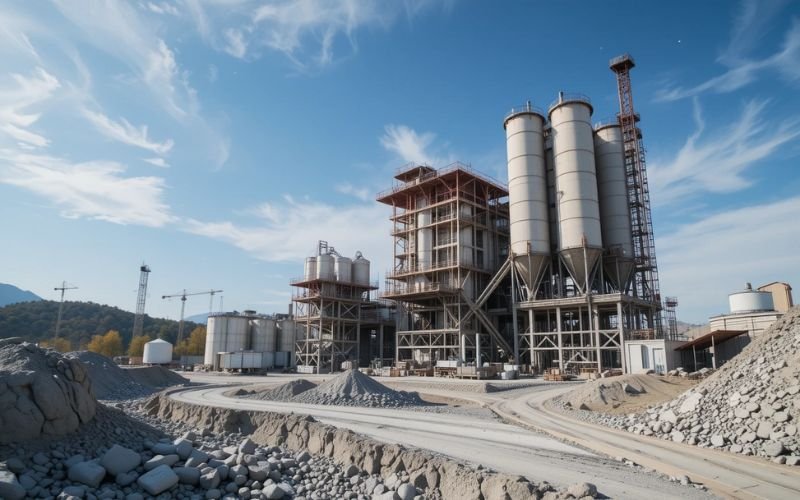Cement Manufacturing Plant Construction in Pakistan
Introduction
Building a cement manufacturing plant is a major investment and a powerful step toward Pakistan’s industrial development. With construction needs on the rise across cities like Lahore, Islamabad, and Karachi, having a local cement plant can offer both economic and logistical benefits. If you are a builder, investor, or industrial client in Pakistan, especially in Lahore, this guide is for you.
Why Invest in a Cement Manufacturing Plant in Pakistan?
Pakistan is experiencing fast growth in construction and real estate. With rising demand for cement across the country, investing in a local cement manufacturing plant can be a smart and profitable move. Here’s why:
1. High Demand for Cement
Infrastructure projects are growing fast in Pakistan. Roads, bridges, housing, and commercial buildings are under construction across the country. The real estate and construction sectors are booming, which is increasing the demand for cement. This growing need makes cement manufacturing a strong investment.
2. Cost Efficiency
Local cement manufacturing helps reduce high transportation costs. It allows easier and faster delivery to nearby construction sites. Producing cement within Pakistan also ensures stable prices and better supply control. This makes operations more profitable and reliable for both manufacturers and builders.
3. Job Creation & Local Growth
Setting up a cement manufacturing plant creates many job opportunities. It provides work for skilled and unskilled labor in nearby areas. This not only helps reduce unemployment but also boosts the local economy, especially in underdeveloped regions. It brings growth and better living standards to communities.
4. Government Support
The government of Pakistan offers strong support for industrial projects. Investors can benefit from tax incentives and reduced duties. Special Economic Zones (SEZs) provide easy access to land, utilities, and flexible regulations. These policies make it easier and more profitable to set up cement manufacturing plants.
Step-by-Step Cement Plant Construction Process
1. Feasibility Study
Before starting a cement manufacturing plant, conduct a detailed feasibility study. Check for the availability of raw materials like limestone and clay near your chosen site. Evaluate reliable energy sources and assess the local market demand for cement. Perform financial and environmental impact analyses to ensure the project’s long-term success and sustainability.
2. Land Acquisition & Legal Approvals
Select a suitable location, preferably within an industrial zone. Verify that the land complies with zoning and infrastructure requirements. Obtain all necessary permits, including environmental clearances and construction approvals. These steps help ensure a smooth and lawful start to the cement plant project.
3. Plant Design & Engineering
Work closely with experienced architects and engineers to design the plant. Prioritize energy-efficient systems to reduce operational costs and environmental impact. Incorporate sustainable and eco-friendly practices for long-term operation. A well-planned design improves productivity and plant reliability.
4. Procurement & Machinery Installation
Source high-quality cement production machinery from trusted suppliers. Install essential equipment such as grinding mills, kilns, crushers, and storage silos with care. Proper installation is key to smooth operations and maximizing plant efficiency.
5. Construction & Civil Works
Build strong foundations and production halls for the plant. Construct utility buildings to support the manufacturing process. Ensure the facility has adequate ventilation and meets fire safety standards. This creates a safe and efficient working environment.
6. Testing & Commissioning
Perform trial runs and thoroughly test all machinery and systems. Confirm that every part operates at optimal performance levels. Identify and resolve any issues before starting full production. This final step guarantees the plant runs efficiently and safely from day one.
Why Choose Highland Properties & Constructions?
1. 17+ Years of Industrial Construction Experience
2. Expertise in Large-Scale Projects like Factories & Cement Plants
3. End-to-End Turnkey Solutions
4. Strong Network of Suppliers & Engineers
5. Commitment to Timely Delivery & Quality Work
We understand the high stakes involved in industrial construction. That’s why Highland provides customized solutions for cement manufacturing plant construction across Pakistan, especially for Lahore-based investors.
Common Challenges in Cement Plant Construction and How to Overcome Them
1. Project Delays: Often caused by poor planning or unexpected site issues.
Tip: Create a detailed schedule and maintain clear communication with all teams.
2. Equipment Sourcing Problems: Finding quality machinery on time can be tough.
Tip: Work with trusted suppliers and order equipment early to avoid delays.
3. Environmental Concerns: Compliance with local laws and regulations is essential.
Tip: Obtain all necessary permits beforehand and follow environmental guidelines strictly.
Good planning and expert support help overcome these challenges and ensure smooth construction.
Estimated Costs and Budget Breakdown for Cement Manufacturing Plant

When planning to build a cement manufacturing plant, having a clear understanding of estimated costs and budget allocation is essential for successful investment and project management. Here is a detailed overview of the key cost components:
1. Machinery and Equipment
This is one of the largest expenses. It includes grinding mills, rotary kilns, crushers, raw material feeders, conveyors, and storage silos. High-quality, energy-efficient machinery ensures better productivity and lower operating costs but may come with a higher upfront price.
2. Operational Expenses
These include ongoing costs such as labor wages, energy consumption (electricity, fuel), maintenance of equipment, raw material procurement (limestone, clay), and environmental management. Efficient operations reduce waste and improve profitability.
Why This Matters
A detailed budget helps investors prepare financially, avoid unexpected expenses, and allocate resources efficiently. It also supports better project planning and risk management, increasing the chances of long-term success in the cement manufacturing business.
Pro Tips for a Successful Cement Plant Project
1. Always opt for energy-efficient technology to reduce long-term costs.
2. Plan logistics: ensure road access, power supply, and water availability.
3. Monitor quality control from design to execution.
4. Keep your project compliant with environmental laws.
Conclusion
Constructing a cement manufacturing plant in Pakistan is not just a business it’s a smart investment in the country’s future. Whether you’re planning to expand your industrial portfolio or secure a steady supply for your construction business, Highland Properties & Constructions is here to guide you every step of the way.
Ready to build your cement plant in Pakistan? Contact Highland today for expert consultation and turnkey project execution.
FAQs
Q1. How long does it take to construct a cement manufacturing plant?
A: Depending on size and scope, it usually takes 18–30 months.
Q2. Can Highland help with permissions and documentation?
A: Yes, we provide full legal support for land, construction, and environmental clearances.
Q3. What is the minimum land size required for a plant?
A: For medium to large-scale plants, at least 100 acres is recommended.
Q4. Is it possible to get a turnkey solution from Highland?
A: Absolutely. We manage everything from design to delivery.





Leave a Reply